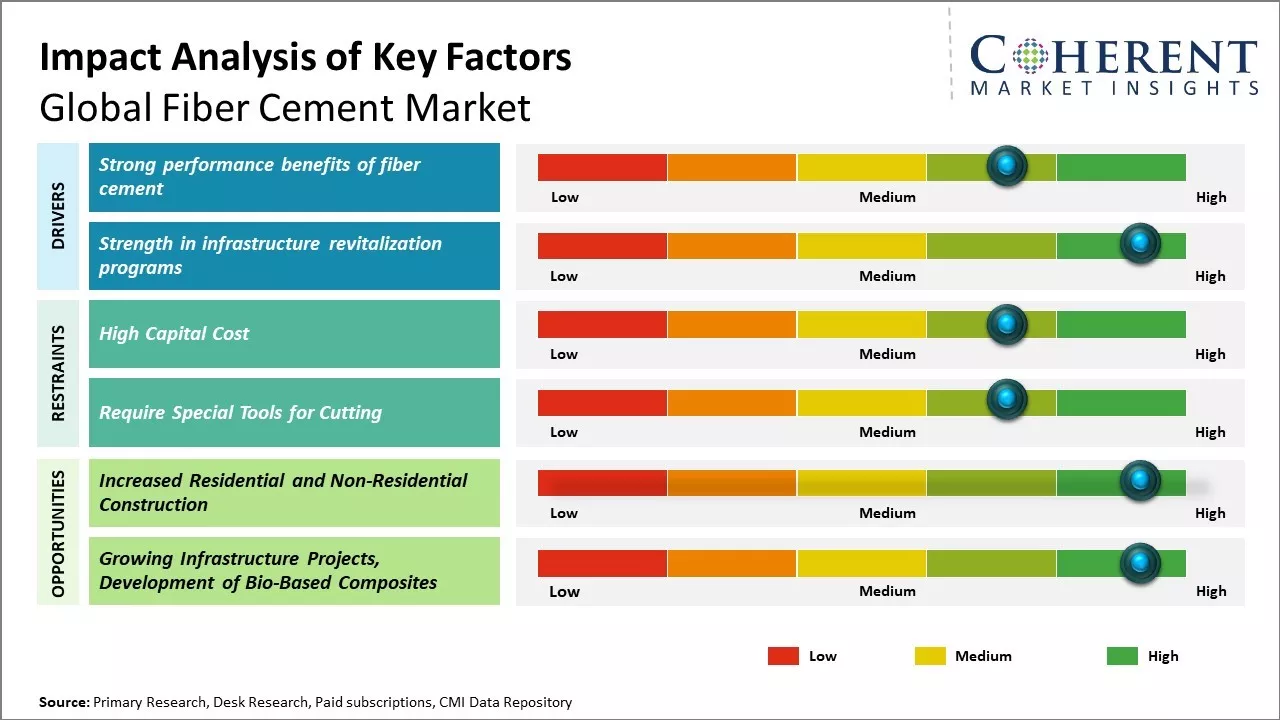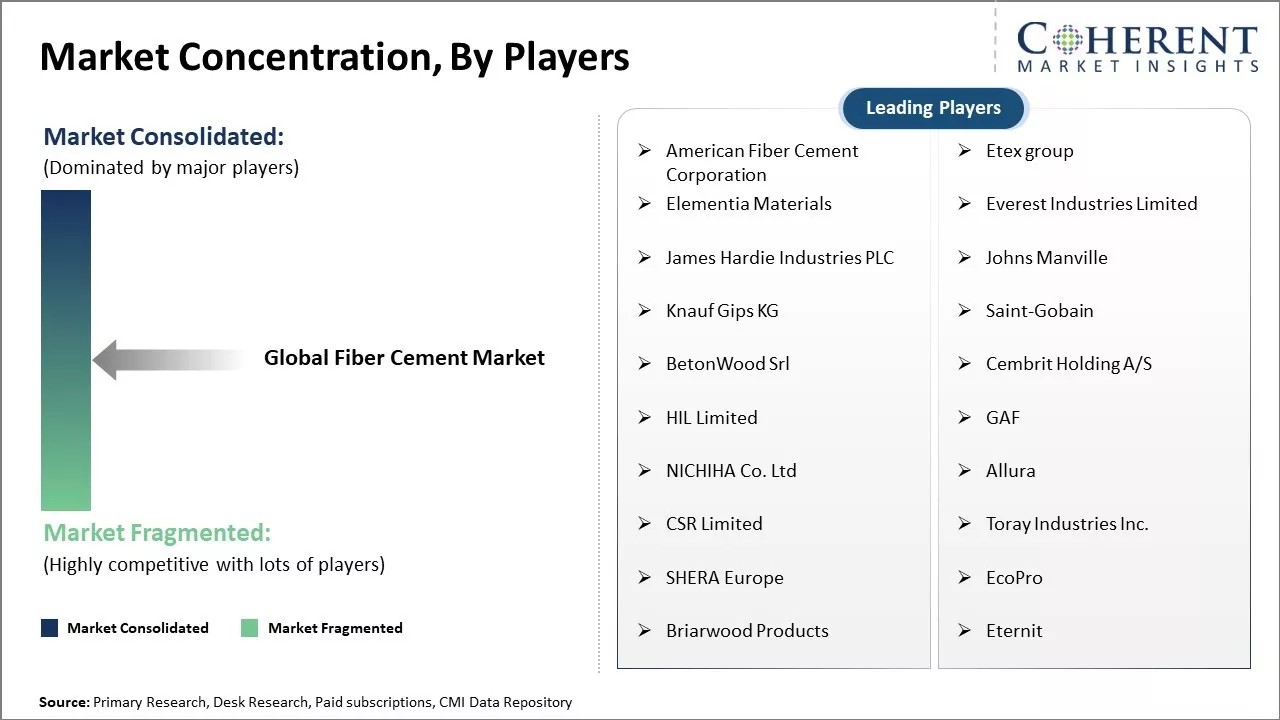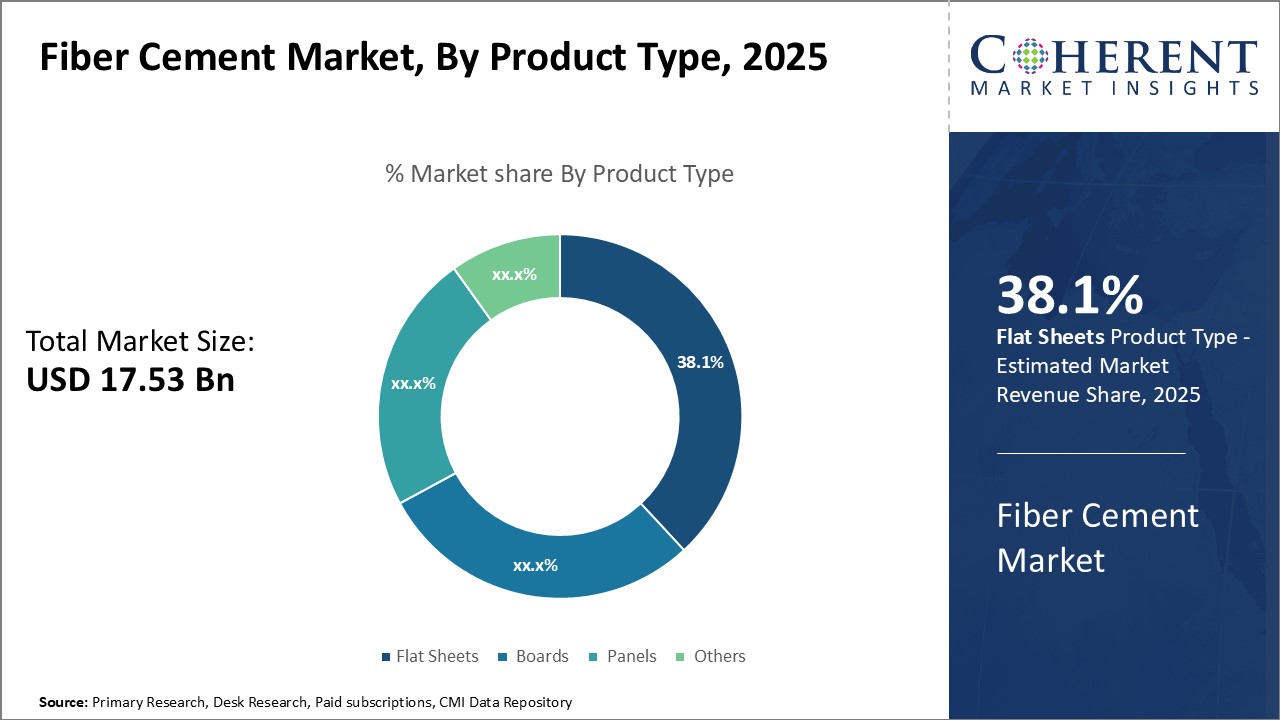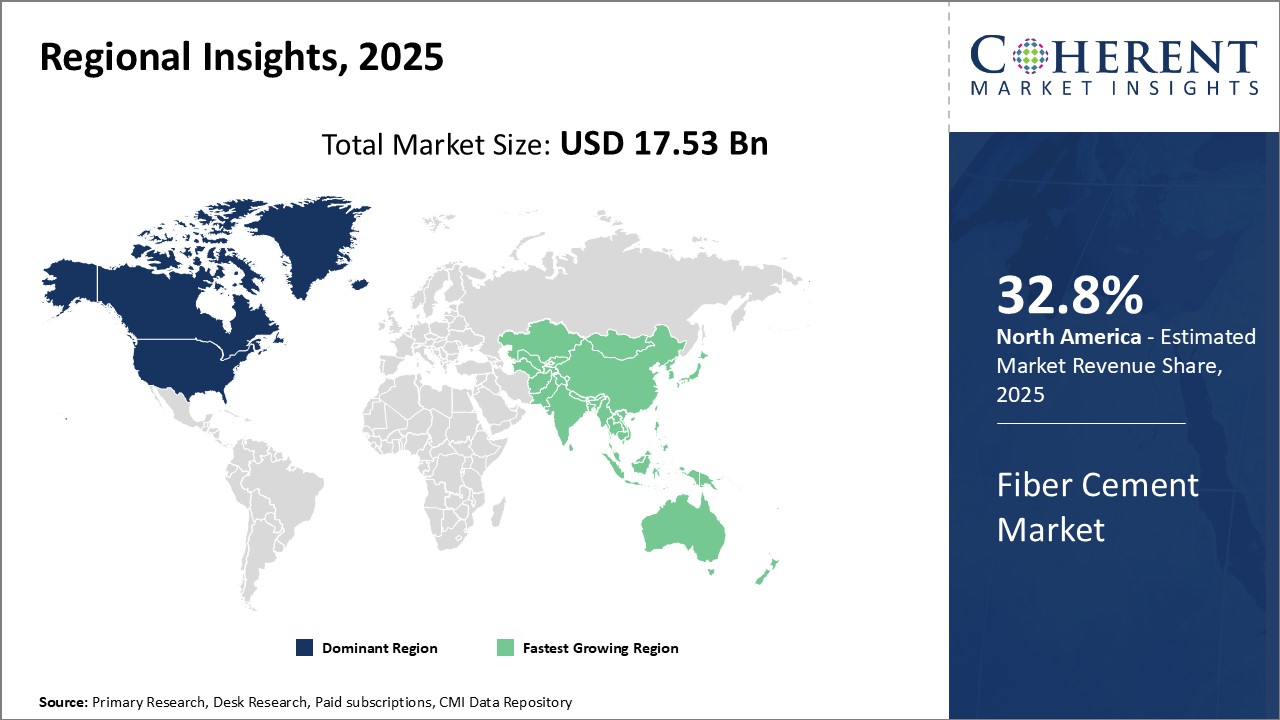The fiber cement market is estimated to be valued at USD 17.53 Bn in 2025 and is expected to reach USD 23.56 Bn by 2032, exhibiting a compound annual growth rate (CAGR) of 4.3% from 2025 to 2032.

Discover market dynamics shaping the industry: Download Free Sample
The fiber cement market is witnessing significant growth driven by rising residential construction activities across developed and developing nations. The demand for fiber cement is increasing in the siding, roofing, and cladding applications due to properties such as durability, fire resistance, and maintenance-free performance. Manufacturers are focusing on product innovation and introducing innovative fiber cement formulations with enhanced attributes. Also, ongoing infrastructure development projects especially in China and India will boost the consumption of fiber cement over the forecast period. However, volatile raw material prices may hamper the market growth to some extent.
Strong performance benefits of fiber cement
Fiber cement is gaining significant traction as an alternative building material due to its superior durability and weather resistance characteristics compared to conventional building products such as wood, brick and stucco. Fiber cement offers an advanced composite material composition that combines natural cellulose fibers with cement materials. The cellulose fibers, such as wood fibers and recycled textiles, offer significant reinforcing properties that improve the tensile strength, flexibility and impact resistance of fiber cement compared to traditional cement materials. This makes fiber cement less prone to cracking and damage from environmental factors. Additionally, the fiber additives help minimize the shrinkage issues associated with cement, thereby enhancing the stability and longevity of fiber cement over time.
The use of fiber cement also allows for thinner and lighter panel designs compared to wooden or masonry alternatives. Thinner panels help minimize thermal bridging and thermal transfers through walls, thereby enhancing the insulation properties of buildings. Some fiber cement formulation variants also incorporate thermal insulation technologies, allowing them to achieve even better thermal insulation performance. The lightweight and rigid nature of fiber cement also simplifies installation processes. Together, the performance advantages of fiber cement like durability, stability and insulation properties are driving its increasing preference over conventional materials for construction applications like siding, roofing, flooring and fascia boards. The minimal maintenance needs of fiber cement further boosts its appeal for commercial and residential construction alike.

Get actionable strategies to beat competition: Download Free Sample
Strength in infrastructure revitalization programs
There is a growing focus among various countries and municipalities on refurbishing and upgrading critical infrastructure facilities such as hospitals, schools, bridges, and government buildings. Much of the existing infrastructure, especially in developed nations of North America and Europe, is aging and requires modernization work to improve structural resilience, accessibility, energy-efficiency, and functionality for the future. Such large-scale revitalization programs involve substantial renovation and re-cladding of exterior walls, roofs and other building envelope elements. This presents a major opportunity for durable and low-maintenance building materials like fiber cement which are well-suited for such refurbishment projects.
Government funding support for infrastructure renewal initiatives will drive higher demand for resilient, long-lasting materials. Fiber cement manufacturers are actively marketing their products for infrastructure revamp programs by emphasizing the performance benefits and lifecycle cost advantages over wood, brick, or aluminum alternatives.
Key Takeaways from Analyst:
The fiber cement market is poised to grow due to rising demand for non-combustible and durable construction materials. The increasing spend on infrastructure projects globally will drive the volume uptake of fiber cement in siding, roofing, and cladding applications. Governments across regions are focusing on public infrastructure to stimulate economic activities post COVID-19. This will benefit market players in the short to medium term.
Availability of cheaper substitutes like vinyl could limit fiber cement's adoption in some developed markets. There is also a rising preference for eco-friendly materials among consumers which may restrain fiber cement's growth considering its carbon footprint. Innovation to develop recyclable and sustainable fiber cement products can help address such concerns.
The Asia Pacific region, led by China and India, offers significant headroom for expansion supported by the ongoing urbanization wave. North America will continue being a lucrative market driven by residential and non-residential construction in the U.S. Europe is also expected to see decent demand fueled by infrastructure investments outlined in the economic recovery packages.
Market Challenges: High Capital Cost
The high capital cost required for setting up manufacturing plants for fiber cement is one of the major factors restraining the growth of the fiber cement market. Fiber cement requires specialized manufacturing facilities as it involves pressing a slurry of sand, cement, and cellulose fibers under high pressure to form panels or boards. Setting up such manufacturing plants requires huge investments which is challenging for many companies.
Market Opportunities: Increased Residential and Non-Residential Construction
Increased residential and non-residential construction provides a major opportunity for growth in the fiber cement market. As urbanization continues and populations grow, the demand for new housing and commercial buildings is booming around the world. According to data from the United Nations, the worldwide urban populations are projected to increase by over 2 billion people by 2050. This surge in urban populations will necessitate unprecedented levels of construction to provide shelter and workplaces for these new residents.

Discover high revenue pocket segments and roadmap to it: Download Free Sample
Insights by product type: Widespread applications of fiber cement
In terms of product type, flat sheets is expected to contribute 38.1% share of the market in 2025. Flat sheets are the most commonly used fiber cement product due to their versatility in construction applications. As pre-coated and pre-finished flat panels, fiber cement sheets are easy and quick to install, making them preferable for exterior cladding on both commercial and residential buildings. Their flat and even texture also allows them to be used as an alternative to traditional wooden or metal panels.
Fiber cement flat sheets do not require much maintenance even after years of use outdoors. This lowers long term costs for building owners. Their fire, impact, and termite resistant properties provide enhanced durability and lifespan compared to wood. The moisture and rot resistance of fiber cement sheets has increased their popularity in humid climates.
Manufacturers offer flat sheets in a variety of widths, lengths, thicknesses, densities, and surface finishes. This allows architects and builders to choose the ideal flat panel for different areas of the building like walls, soffits and facades. Pre-cut or rip-cut sheets in standard sizes facilitate faster installation. The trend of modular construction has also boosted demand for fiber cement flat panels.
Insights by application: Growth in construction activity
Exterior walls is expected to contribute 32.7% share of the market in 2025. Exterior walls account for the largest application segment due to the increased construction of both residential and non-residential buildings. Fiber cement is a preferred material for siding on walls as it offers an attractive and long-lasting finish. Its fireproof qualities meet strict building codes for external cladding.
Global growth in infrastructure development and urbanization is driving more construction of offices, malls, hospitals, and hotels - key contributors to the exterior walls segment. Rapid housing construction in developing countries also boosts fiber cement demand for walling. The ease of installation compared to masonry reduces labor costs. Many architects specify fiber cement sheets for their moisture resistant and termite-proof properties essential for exterior walls.
Manufacturers have enhanced fiber cement sheets for walls by embedding polymers and adding novel surface designs. Textured sheets that resemble wood, marble or stone give superior aesthetics. This has increased acceptance of fiber cement as a mainstream building material rather than just a cost-effective solution.

Need a Different Region or Segment? Download Free Sample
North America has been dominating the global fiber cement market for years owing to a strong presence of key players in the region. The region is expected to account for 32.8% of the market share in 2025. The U.S. accounts for the largest share in the fiber cement market in North America. This can be attributed to the robust construction industry in the country and increasing remodeling & renovation activities. Moreover, the rising trend of sustainable and eco-friendly construction materials has significantly propelled the sales of fiber cement boards in both residential and non-residential applications. Manufacturers in the region also offer customized product solutions to cater project-specific requirements, thereby appealing to broader customer base. While exports are limited, North America fulfills majority of its fiber cement demand through strong domestic manufacturing capabilities and abundant availability of raw materials.
The Asia Pacific region has emerged as the fastest growing market for fiber cement globally in recent times. China represents the lion's share of fiber cement market in Asia Pacific attributed to low-cost manufacturing and availability of skilled labor. Additionally, the increasing government emphasis on infrastructure development to propel economic growth has strengthened the demand from non-residential vertical. India is also witnessing an uptick in fiber cement consumption owing to rapid urbanization, growing housing backlog, and strong momentum in the real estate sector. Southeast Asian countries like Vietnam, Indonesia, and Malaysia are expected to create significant opportunities for manufacturers due to their export-driven manufacturing capabilities. While imports play an important role in fulfilling the massive demand, local players in the Asia Pacific region have strengthened their fiber cement production over the years to effectively compete with global leaders.
Fiber Cement Market Report Coverage
| Report Coverage | Details | ||
|---|---|---|---|
| Base Year: | 2024 | Market Size in 2025: | USD 17.53 Bn |
| Historical Data for: | 2020 To 2024 | Forecast Period: | 2025 To 2032 |
| Forecast Period 2025 to 2032 CAGR: | 4.3% | 2032 Value Projection: | USD 23.56 Bn |
| Geographies covered: |
|
||
| Segments covered: |
|
||
| Companies covered: |
American Fiber Cement Corporation, Etex group, Elementia Materials, Everest Industries Limited, James Hardie Industries PLC, Johns Manville, Knauf Gips KG, Saint-Gobain, BetonWood Srl, Cembrit Holding A/S, HIL Limited, GAF, NICHIHA Co. Ltd, Allura , CSR Limited , Toray Industries Inc. , SHERA Europe, EcoPro, Briarwood Products, and Eternit |
||
| Growth Drivers: |
|
||
| Restraints & Challenges: |
|
||
Uncover macros and micros vetted on 75+ parameters: Get instant access to report
*Definition: The fiber cement market involves the production and sales of fiber cement products. Fiber cement is a building material used in both commercial and residential applications that consists of cement, sand, and cellulose fibers. Products in the fiber cement market include fiber cement siding, backerboards, panels, shingles, roofing, siding, trim and fascia, ceiling boards, and floor underlayments. These durable, low maintenance fiber cement materials are used as an alternative to traditional wood or vinyl siding for exterior and interior applications. The global fiber cement market has grown in recent years due to increased construction activity and demand for moisture and fire resistant building materials.
Share
Share
About Author
Yash Doshi is a Senior Management Consultant. He has 12+ years of experience in conducting research and handling consulting projects across verticals in APAC, EMEA, and the Americas.
He brings strong acumen in helping chemical companies navigate complex challenges and identify growth opportunities. He has deep expertise across the chemicals value chain, including commodity, specialty and fine chemicals, plastics and polymers, and petrochemicals. Yash is a sought-after speaker at industry conferences and contributes to various publications on topics related commodity, specialty and fine chemicals, plastics and polymers, and petrochemicals.
Missing comfort of reading report in your local language? Find your preferred language :
Transform your Strategy with Exclusive Trending Reports :
Frequently Asked Questions
Joining thousands of companies around the world committed to making the Excellent Business Solutions.
View All Our Clients